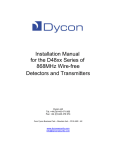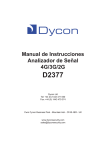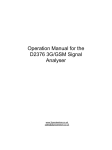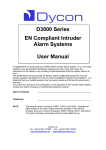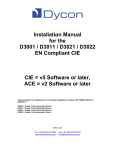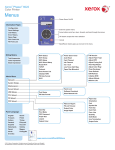Download Installation Manual for D1110 DigiCom2
Transcript
Installation Manual for D1110 DigiCom2 Dycon Ltd Tel: +44 (0)1443 471 060 Fax: +44 (0)1443 479 374 Cwm Cynon Business Park – Mountain Ash – CF45 4ER - UK www.dyconsecurity.com [email protected] TABLE OF CONTENTS Section Index 1 2 Description Part numbers 3 3 3 4 5 6 What to do: Installation System testing Troubleshooting Helpdesk 4 4 5 5 The details: Inputs and self learning System power supply and battery NVM programming, line monitoring Calling Select services Inputs 1 – 8 Automatic test calls PSTN line monitor Output 6 6 7 7 7 7 7 7 8 Appendix 1 – LED indications Appendix 2 – Input connections Appendix 3 – Specification Appendix 4 – Approvals Appendix 5 – Glossary of terms 9 10 13 14 15 7 8 9 9.1 9.2 9.3 9.4 9.5 9.6 D1110 DigiCom2 Installation Manual - D1110-INST-EN/10F/v1 Page -2 DigiCom2 Installation Manual 1. Description The DigiCom2 is an advanced auto-dialing digital communicator for alarm reporting. It can transmit alarm signals to an Alarm Receiving Centre via the analogue PSTN (Public Switched Telephone Network) using the ‘DTMF Fast Format’ protocol. The DigiCom2 has 8 alarm inputs. When triggered by the alarm system, it initiates calls to the Alarm Receiving Centre (ARC). The DigiCom2 monitors the PSTN line continuously. If a fault occurs local annunciation is made. The DigiCom2 comes complete with the “Alarm Abort” feature to enable older alarm systems to comply with the ACPO false alarm policy (in the UK). Once the system is set, if a mis-operation occurs and the system is unset within 90 seconds, a “Restore on Channel 3” or separate code will be sent to the Alarm Receiving Centre. The DigiCom2 is housed in an ABS plastic case which protects the electronics. A tamper protected steel box with an integral 1 amp power supply is also available. See below for part numbers. An NVM Programmer D1154 is available that connects to a PC. 2. Part numbers D1110 D1055 D0354 D1154 D1520-B D0730 D0402 DigiCom2 Box of 10 NVM ICs NVM programmer NVM programmer software Tamper protected box with 1 amp, En-compliant Grade 2 power supply Security ADSL (broadband) filter Dycon products CD with manuals for all products Fig. 1 – DigiCom2 D1110 D1110 DigiCom2 Installation Manual - D1110-INST-EN/10F/v1 -3 3. Installation Program the NVM for the system specific requirements, or obtain a programmed NVM from your Alarm Receiving Centre. See page 15. 1. 2. 3. 4. 5. 6. 7. Totally power down the control panel mains and battery. Fit the (programmed) NVM into the 8-pin socket located at the front of the DigiCom2 module ensuring correct orientation. See Fig 1. The NVM should be programmed with the D1154 NVM programmer. Connect the input triggers as required. See Fig 1 and ‘Self Learning Inputs’ on page 6. Connect the PSTN line to the terminals A and B. See pages 7 to 14. Connect the 12 volt supply to the ‘12v +’ & ‘12v -’ terminals. See Fig 1 and page 14. Reconnect the mains supply to the control panel. Your DigiCom2 is now ready for testing. 4. System Testing Ensure you have informed your Alarm Receiving Centre that you are ready to test your DigiCom product. Note: If the NVM is faulty, fitted incorrectly or has been incorrectly programmed, the red and yellow LEDs will flash alternately. If there is a problem with the PSTN telephone line, the red LED will flash. See Appendix 1. 1. 2. 3. 4. 5. 6. 7. 8. Power up the DigiCom2 - the unit will initialise. Start testing by momentarily shorting the test pins on the DigiCom2. This will cause the DigiCom2 to send a test signal to the Alarm Receiving Centre. Once the test pins are shorted, the “Active” LED will illuminate. During communication the LED will flash to indicate the progress of the call, see Appendix 1. When the DigiCom2 successfully communicates with the Alarm Receiving Centre, the “Active” LED will go off, this will mean that the test call is complete. Now trigger all the used inputs on the DigiCom2. This should be done by setting the control panel and triggering an alarm condition. If PA or fire circuits are being monitored, these should also be triggered. Contact your Alarm Receiving Centre to confirm that all signals have been received. Ensure that all ‘Restore’ signals are received when the DigiCom2 input terminals return to their quiescent value. If the quiescent (non-active) states of the input terminals are incorrect, i.e. “positive applied/removed” is inverted, then the ARC will report that the alarm/restore or open/close is the ‘wrong way round. To correct this, use the self learning input feature. See page 6. If at any time you wish to cancel a call, short the reset pins. See Fig. 1. If you are using the “Alarm Abort” feature, set the alarm panel, initiate an alarm condition and (if the alarm system incorporates bell delay this will be overridden), unset the system within 90 seconds. Check that the alarm abort signal has been sent to the Alarm Receiving Centre and, if selected the alarm system has reset. Your DigiCom2 is now fully tested. D1110 DigiCom2 Installation Manual - D1110-INST-EN/10F/v1 -4 5. Troubleshooting Q. What if there appears to be random triggering of the DigiCom2? Ensure that 0 volts is common across all parts of the alarm system. If the DigiCom2 receives its power from a power supply that is additional to the alarm system, ensure that the 0 volt connection on the additional power supply is connected to the 0 volt connection on the alarm system. Check that the supply voltage is sufficient for reliable operation. A supply voltage below 9v will damage the standby battery and may generate spurious signals. Q. What if the digital communicator is not received by the Alarm Receiving Centre? Check that the NVM is fitted and has been correctly programmed, i.e. correct telephone numbers. Check that the PSTN line is properly connected. Check with a meter that approximately 48 volts DC is present across the PSTN terminals marked A and B. Connect a telephone to the PSTN line and make a call to ensure that it is fully functional. Remove telephone after test. Disconnect any other equipment that is using the same PSTN line to ensure that it is not inhibiting the DigiCom2. Check that when the digital communicator is triggered, the voltage across the A and B terminals drops to between 6 and 12 volts DC. Ensure that ‘call barring’ to the ARC Receiver telephone number has not been set on the PSTN line used by Digicom. See Appendix 1 for line monitoring indications. These will help diagnose line problems. Q. What if some channels are not received correctly by the Alarm Receiving Centre? Check that the NVM has been correctly programmed for your requirements. Repeat the ‘Learning the Inputs’ programming stage. 6. Help Desk If you have installed the DigiCom2 in accordance with these instructions, checked all the above points but are still experiencing problems you can contact your DigiCom2 supplier or your Telecom Service Provider. In the UK, DigiCom2 installation, programming, operation or other questions may be addressed to: Dycon Technical Support: Tel: +44 (0)1443 471 064 Email: [email protected] The Dycon web site: www.dyconsecurity.com contains the latest copies of all manuals for all Dycon products. Please ensure that you are working from the latest version. You can also download associated information and software samplers. Sales, shipping and contact information is here too. A CD is available that contains manuals for all Dycon products and the programming software for DigiCom and Dualcom. Contact our Technical Support for more information. D1110 DigiCom2 Installation Manual - D1110-INST-EN/10F/v1 -5 7. Inputs and Self Learning For full Inputs connection information see Appendix 2. To aid installation, the DigiCom2 can learn the quiescent state of its inputs, i.e. the ‘not active’ state, without having to re-program the NVM. This allows the unit to be programmed during installation with ‘positive applied’ or ‘positive removed’ inputs. It will correct NVMs that have been supplied with incorrect input polarities. 1. 2. 3. 4. 5. Setup the inputs ‘non-active’ conditions by connecting a positive voltage or ‘no’ voltage (0v) on each input terminal as required. This is easily achieved by connecting the control panel outputs to the DigiCom2 inputs, then put the control panel in the day state with no activated detectors and all alarm conditions reset. You can leave any unused DigiCom2 inputs disconnected. ‘Non-active’ means that the voltage on the alarm inputs are in the ‘not in alarm” condition and open/close inputs are in the ‘open’, ‘unset’ or ‘day’ condition. Ensure that the unset/open/day state is selected on the control panel, not the ‘set’ or ‘engineering’ states. With the DigiCom2 powered up, apply a permanent short to the test pins with a jumper link or screwdriver blade etc… Momentarily short the reset pins. The red and yellow LEDs will flash: 3 red... 3 yellow... 3 red... etc… indicating ‘learning’ mode. Remove the short on the test pins. The LED flashing will cease and the state of the 8 inputs will be remembered as the ‘nonactive’ condition. This information will be stored in the NVM. When complete, DO NOT park the jumper link onto BOTH test pins because this will immediately trigger a test call and inhibit further operation. 8. System Power Supply and Battery The DigiCom2 requires a supply of 12-13.8 volts DC at 6mA in standby and 20mA when activated. The installer must ensure that the alarm system power supply is rated to provide adequate power for this apparatus and for any other auxiliary apparatus drawing power from the alarm system power supply. If the supply voltage falls to below 11v, a “Low Voltage” signal will be transmitted to the ARC. If the standby battery voltage falls below 9v (deep discharge), the battery may sustain permanent damage. The DigiCom2 will, however, remain operational, but the red Fault LED will be permanently on. If the DigiCom2 receives its power from a power supply that is additional to the alarm system, ensure that the 0 volt connection on the additional power supply is connected to the 0 volt connection on the alarm system. Only power supplies conforming to EN60950, EN41003 or International Safety Standards should be used with this apparatus. D1110 DigiCom2 Installation Manual - D1110-INST-EN/10F/v1 -6 9. NVM Programming The operating parameters for the DigiCom2, e.g. telephone numbers, are stored in the NVM (Non Volatile Memory). The DigiCom2 is designed to use an NVM that has been specifically programmed for it, or an NVM that has been programmed for a Scantronic 8400, 8440 or 9056 Digital Communicator. Note: when using a Scantronic NVM, the option to specify regular dial-tone tests or the ACPO Abort features will not be available. The NVM can be programmed using the D1154 NVM programmer connected to a PC. The NVM can also be programmed by a Scantronic-type 7200 or 7300 programmer. Your Alarm Receiving Centre will normally provide a programming service and will supply programmed NVMs on request. Professional installers may also have the D1154 and be able to provide a DigiCom2 programming service. For a full list of programmable features see instructions for the D1154 NVM programmer. 9.1 Calling a) DTMF Dialing b) Three Way Calling (Select Services) c) Three or four telephone numbers for PSTN alarm reporting. 9.2 Select Services If the PSTN line for the DigiCom2 is not ‘outgoing calls only’, we recommend that your Telecom Service Provider’s “Three Way Calling“ service (if available) is enabled on the phone line. The NVM will need to be programmed with “3-way calling” enabled. This will ensure that the DigiCom2 can make an outgoing PSTN call if the line is engaged by an incoming call. See page 10 for recommended connections for security applications. 9.3 Inputs 1 - 8 There are 8 inputs on the DigiCom2. These inputs require 0 volts or a DC positive voltage (+4v to +15v) to operate. They may be programmed to send an alarm call when a positive voltage is applied to an input or when a positive voltage is removed, i.e. the input voltage is changed to 0 volts. To assist triggering, there is one output terminal labelled ‘Stt +’ that supplies +12 volts via a resistor. See Appendix 2. 9.4 Automatic Test Calls Periodic test calls can be sent at intervals of 1 to 99 hours since the last call was made. 9.5 PSTN Line Monitoring Any or all of the following PSTN tests may be switched on. If a problem is detected, the DigiCom2 can operate the Aux relay: a) 24 Hour DC Voltage b) 24 Hour Off Hook Detect c) 24 Hour Ringing Detect d) Regular Dial Tone Detect D1110 DigiCom2 Installation Manual - D1110-INST-EN/10F/v1 -7 9.6 Output One output is provided. The connections marked Aux can be programmed to operate: a) When a line fault is detected b) If a communication attempt fails c) If a communication attempt is successful d) When a communication attempt is in progress The Aux output may also be programmed to be normally on or normally off. In addition, the output can be inverted by shorting the INV pins on the DigiCom2. The Aux output may be programmed to be timed or latched. If latched, the Aux relay will remain in its active state until the DigiCom2 is reset or power is removed and restored. D1110 DigiCom2 Installation Manual - D1110-INST-EN/10F/v1 -8 APPENDIX 1 LED Indications The LEDs are red and yellow, and labelled as ‘Fault’ and ‘Active’. See Fig 1. Input Learning Indication When the DigiCom2 is ‘learning’ the quiescent (non-active) state of its inputs, the red and yellow LEDs will flash: 3 red... 3 yellow... 3 red... etc… NVM Fault Indications LEDS alternate flash - slow (red, yellow, red, yellow ...) NVM is faulty or fitted incorrectly LEDS alternate flash – fast (red, yellow, red, yellow ...) (on and off 5 times per sec) NVM is the correct type and is working, but has been incorrectly programmed Communication indications The yellow “Active” LED will flash to indicate the progress of the call. LED Off PSTN path not activated LED On solid PSTN activated LED Slow flash Dialing or waiting for ‘handshake’ from receiving equipment LED Rapid flash Handshake received, sending data to receiving equipment LED 6 slow flashes Communications successful. Data received correctly at receiving equipment Both ON D1110 is resetting PSTN Line Failure Indications The Fault LED will flash to indicate the type of line or communication failure. If more than one type of failure is detected, the lowest number will be displayed. 1 flash PSTN telephone line DC voltage is very low or absent 2 flashes Another telephone (or fax, modem etc…) on the same PSTN line is off-hook and can inhibit the DigiCom2 from making a telephone call 3 flashes Incoming ringing is detected and this will inhibit the DigiCom2 from making a telephone call On Supply voltage to DigiCom is very low D1110 DigiCom2 Installation Manual - D1110-INST-EN/10F/v1 -9 APPENDIX 2 Input Connections There are 8 input terminals on the DigiCom2. When the DigiCom2 is triggered, the voltages on the input terminals are 0 volts changing to a positive voltage (+4 volts to +12 volts), or they may be a positive voltage changing to 0 volts. This is called ‘positive applied’ or ‘positive removed’ triggering. All voltages are measured with respect to 0 volts. The inputs may be programmed to send an alarm call when a positive voltage is applied to an input or when a positive voltage is removed. See the D1154 NVM Programming Manual for details. Note: Triggering voltages in excess of +16 volts may cause spurious operation. The DigiCom2 can ‘self learn’ its inputs and correct the NVM. See page 6. ST+ Fig. 11 The diagram above shows the internal connections of the DigiCom2. The +12 volt and 0v supply connections from the control panel or power supply is connected to the +12v and - 12v terminals. Each of the input terminals on the DigiCom2 is connected to 0 volts by a resistor. Therefore, by leaving an input terminal unconnected will ensure that that input is connected to 0 volts and is unused. The ‘Start+’ (ST+) terminal on the DigiCom2 is an output. It will give a positive ’pull-up’ voltage which can be used to assist input triggering. See page 11. D1110 DigiCom2 Installation Manual - D1110-INST-EN/10F/v1 - 10 APPENDIX 2 Input Connections (cont’d) D1110 DigiCom2 Installation Manual - D1110-INST-EN/10F/v1 - 11 APPENDIX 2 Input Connections (cont’d) D1110 DigiCom2 Installation Manual - D1110-INST-EN/10F/v1 - 12 APPENDIX 3 Specification Model D1110 Stand Alone Dimensions (h x w x d) 19 x 61 x 91 mm Weight 80 grams Telephone Path Standard PSTN technology Abort Facility Built-in Power Requirement Max 13.8v Min 9.0v DC, 0.1volt max ripple Current Consumption 6mA quiescent, 20mA operating Low Battery 10.9-11.1 volts falling, 11.9-12.1v recovery Outputs 1 Aux relay (24v 1A contacts) Start Inputs Max +15 volt, Min +3.5 volts DC Temperature -20°C to +60°C transit, -4°C to +5°0C operating Humidity 0 - 80% non-condensing Mounting Any orientation Warranty 2 years D1110 DigiCom2 Installation Manual - D1110-INST-EN/10F/v1 - 13 APPENDIX 4 European PSTN Approval The D1110 range of DigiCom2 products meets the requirements of the EU PSTN standard CTR21 and is approved for connection to any exchange line forming part of a Public Switched Telephone Network (PSTN). AHCTR210 001 Declaration of Network Compatibility The equipment has been approved in accordance with Council Decision 98/ / EC ( 5 ) for pan-European single terminal connection to the Public Switched Telephone Network (PSTN). However, due to differences between the individual PSTNs provided in different countries, the approval does not, of itself, give an unconditional assurance of successful operation on every PSTN network termination point. In the event of problems, you should contact your equipment supplier in the first instance. AHCTR211 001 Statement to Notified Body, Vendor and User The equipment has been approved in accordance with Council Decision 98/ / EC ( 5 ) for pan-European single terminal connection to the Public Switched Telephone Network (PSTN). The equipment has been designed for use in all 17 EU countries, plus Switzerland, but may have interworking difficulties in Germany and Greece. For use in Portugal it is necessary to ensure that a programming master chip, catalogue number D1145-02 is used to ensure reliable operation with the Portuguese telephone network. Approval Authority: CE0168 D1110 DigiCom2 Installation Manual - D1110-INST-EN/10F/v1 - 14 APPENDIX 5 Glossary of Terms Alarm Abort A facility to reduce false alarms requiring police response. Specified by ACPO (The Association of Chief Police Officers) in the UK. An “Alarm Abort” situation occurs when the alarm system is set, and an alarm occurs, and it is then reset by the alarm system being unset by a key or valid user code, all within 90 seconds. This false alarm is often caused by the user of an alarm system failing to set the system correctly. The “Alarm Abort” signal identifies this situation to the ARC thus avoiding an unnecessary police visit to the site. Analogue PSTN - Analogue Public Switched Telephone Network. The analogue national telephone system, often just called the PSTN. Service is available to customers on twisted-pair wires that carries a DC supply provided from the network telephone exchange. ARC - Alarm Receiving Centre See ARS. ARS - Alarm Receiving Station A 24-hour manned centre (often privately owned and operated) capable of receiving and logging calls of alarm, and forwarding them to security authorities and other relevant services. Often called a Central Station. Call Minder A call answering service offered by some telecom Service Providers. When an incomming call to the subscriber’s telephone is not answered, the Service Provider can record it and forward it to the subscriber at a later time. Central Station See ARS. Digital PSTN - Digital Public Switched Telephone Network. The digital national telephone system. Service is available to customers on twisted-pair wires that carry a DC supply provided from the network telephone exchange, on optical fibre or other digital transmission medium. The digital service may be in ISDN format or another digital format. DTMF - Dual Tone Multi Frequency The series of tones used by telephones to send dialling information to an analogue PSTN exchange. These tones are also used by the DTMF Fast Format and Contact ID alarms reporting protocols. DTMF Fast Format - Alarms Reporting Protocol A protocol that is a sequence of analogue tones (push-button telephone tones) used to send via telephone lines a transmission to receiving equipment at an ARC, and to receive checking and acknowledgement replies from that receiving equipment. Eight or 16-channel DTMF Fast Format protocol is commonly used in burglar or intruder alarm equipment. EEPROM - Electrically Erasable Programmable Read Only Memory. A type of NVM. See NVM. NTP - Network Termination Point A telephone line is terminated at the users premises by a Network Termination Point which is provided by the Telecomms Service Provider. This is a socket or connection where the users equipment can be connected. NVM - Non Volatile Memory. An integrated circuit memory device that does not need any power to remember data. D1110 DigiCom2 Installation Manual - D1110-INST-EN/10F/v1 - 15 APPENDIX 5 Glossary of Terms (cont’d) PABX - Private Automatic Branch Exchange A small telephone exchange for use within one building or group of buildings. Commonly used in businesses where each phone in that business is an extension on that PABX. Usually connects to one or more analogue PSTN or ISDN telephone lines. PSTN - Public Switched Telephone Network. A national telephone system. This may be analogue and/or digital. See analogue PSTN. Terminal Adapter A device that connects to the S-bus connection of an ISDN Network Termination Point and adapts the digital S-bus data, i.e. protocol, data speed, structure, to that required, e.g. the conversion may be to analogue PSTN or to a serial port for cable connection to a PC’s serial ‘COM’ port. 3-Way-Calling This is a service provided by some telecommunication service providers. BT in the UK offers this service. When a call is in progress on a telephone line it is possible to send a signal via that line to the equipment at the telephone exchange. The exchange will put the current call on ‘hold’ and provide a dialing tone so that another outgoing call may be made. When this second call has finished a signal to the exchange will disconnect the second call and re-connect the first one that was put on ‘hold’. D1110 DigiCom2 Installation Manual - D1110-INST-EN/10F/v1 - 16























